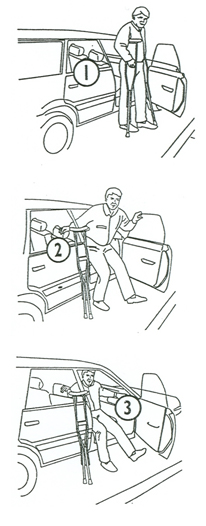Your Guide After a Hip Fracture
Getting In and Out of A Car
Page Content
You won’t be allowed to drive until your doctor says it’s okay. You’re responsible for driving safely. To drive safely, your strength and reflexes need to be as good as before your hip fracture. If you’re in an accident, your insurance may not cover you if you’re not safe to drive. For more information, contact the Reviewing Officer at any Alberta Registries for Motor Vehicles.
You may find a higher vehicle easier to get into/out of (depending on your height). Avoid small cars, low bucket seats, and vehicles that you have to step up into, if you can. Sit in the front seat whenever possible. Your therapist will tell you how to do car transfers depending on the car.
Have your driver park the car about 1 metre (3 feet) away from the curb. Have the driver slide the passenger seat back as far as it will go. You may find that placing a large plastic bag on the seat makes sliding into and out of the car much easier.
- Back up with your walking aid until you can feel the edge of the car against the back of your legs.
- Hold onto the back of the seat and the car frame for support. Slide your operated leg forward slightly, bend both your knees, and lower yourself onto the car seat. Watch your head!
- Slide your buttocks toward the middle of the car then pivot on your buttocks as you lift your legs one at a time into the car.
Reverse the procedure to get out of the car.
|  |
Current as of: January 9, 2015
Author: Bone and Joint Health Strategic Clinical Network, Alberta Health Services
